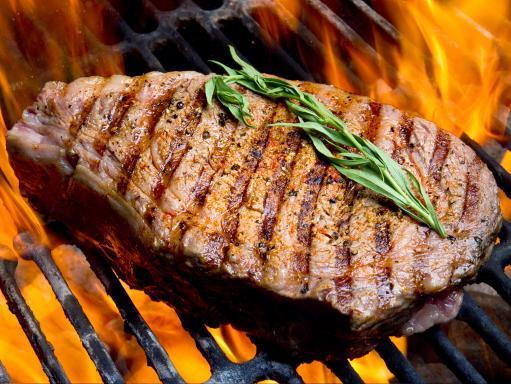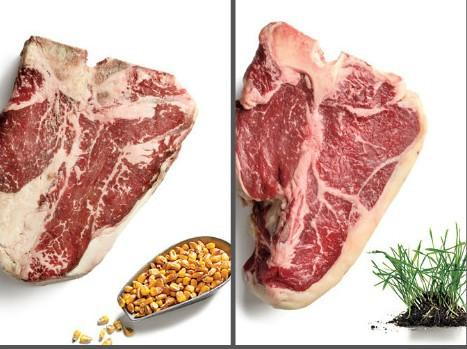- posted: Jan. 17, 2017
This week, we wanted to discuss the nutritional and environmental benefits of choosing organic, grass-fed beef. We all know that conventional beef is full of antibiotics, steroids, and hormones. We will touch on these added hormones, but want to focus on the superior nutritional quality of grass-fed beef and encourage you to "vote with your dollars" while you shop. Also, we have a special announcement from Joan VanDewater about vaccinations. As always, enjoy this week's beef-centered recipes and current office happenings!

Antibiotics/Steroids/Hormones
It is well-known that our conventionally-raised beef is packed with antibiotics and other unfavorable additives. Did you know that 80 percent of the antibiotics sold in the US are used on livestock? We found that number to be staggering. Currently, the FDA has approved 3 natural hormones (estradiol, testosterone, and progesterone) and 3 synthetic hormones (the estrogen compound zeranol, the androgen trenbolone acetate, and progestin melengestrol acetate) to be used on livestock. We can't see how it is a good idea to spike our food with hormones that we would otherwise avoid. The FDA states that "These steroid hormone drugs are typically formulated as pellets or “implants” that are placed under the skin on the back side of the animal’s ear. The implants dissolve slowly under the skin and do not require removal. The ears of the treated animals are discarded at slaughter and are not used for human food. Using scientific data, FDA establishes the acceptable safe limits for hormones in meat. A safe level for human consumption is a level of drug in the meat that would be expected to have no harmful effect in humans based on extensive scientific study and review."
http://www.healthychild.org/easy-steps/keep-hormones-and-antibiotics-off-the-menu/
http://www.fda.gov/AnimalVeterinary/SafetyHealth/ProductSafetyInformation/ucm055436.htm
Buy Grass-Fed Beef for Nutrition
Omega-3 Fatty Acids
Grass-fed beef contains up to 5-times the amount of Omega-3 Fatty Acids found in grain-fed beef. We tend to think that Omega 3's come from fish and flax seeds, however grass-fed beef can be a rich source as well! Omega-3 fatty acids play a vital role in every cell and system in your body. For example, they are helpful in maintaining heart health. People who have ample amounts of Omega-3s in their diet are less likely to have high blood pressure, an irregular heartbeat, and are less likely to have a serious heart attack. Omega-3s are essential for the health of your brain as well. People who consume a diet rich in omega-3s are less likely to be afflicted with depression, schizophrenia, attention deficit disorder (hyperactivity), and Alzheimer’s disease.
Conjugated Linoleic Acid (CLA)
Grass-fed beef contains about twice as much CLA as grain-fed beef. This fatty acid is associated with reduced body fat as well as some other beneficial effects. CLA may be one of our strongest defenses against cancer. In laboratory animals, consuming a diet rich in CLA greatly reduced tumor growth. You may be able to lower your risk of cancer simply by eating grass-fed meats regularly. You would have to eat five times that amount of grain-fed meat to get the same level of protection. In a Finnish study, women who had the highest levels of CLA in their diet, had a 60 percent lower risk of breast cancer than those with the lowest levels of CLA in their diet.
Vitamin E
Grass-fed beef is significantly higher in Vitamin E than conventionally-raised beef. Vitamin E is a powerful, fat-soluble antioxidant that helps protect cell membranes against damage caused by free radicals, and prevents the oxidation of LDL cholesterol. Vitamin E is also necessary for structural and functional maintenance of skeletal, cardiac, and smooth muscle. It also assists in the formation of red blood cells and helps to maintain stores of vitamins A and K, as well as iron and selenium. It may have a positive effect on immune health, protect against the oxidative damage that can lead to heart disease, have preventive effects against cancer, help relieve symptoms of Alzheimer's disease, and may help prevent some diabetes-related damage, particularly to the eyes.
Beta-Carotene

The photo above illustrates the differences between corn-fed and grain-fed beef. The presence of the yellow fat in the photo on the right illustrates the presence of beta carotene. As we discussed last week, beta-carotene is a natural form of Vitamin A, an essential nutrient which the body can convert to Vitamin A as needed. Beta-carotene is also an antioxidant, important for protecting the body against free-radicals. Beta-carotene is found in plants including grass, and is not present in grain, which is indicated by the white color of the fat.
Buy Grass-fed Beef For the Environment
The corn we feed our feedlot cattle accounts for a staggering amount of fossil fuel energy. Growing the corn used to feed livestock takes vast quantities of chemical fertilizer, which in turn takes vast quantities of oil. Because of this dependence on petroleum, a typical steer will in effect consume 284 gallons of oil in his lifetime. In addition to consuming less energy, grass-fed beef has another environmental advantage; it is far less polluting. The animals’ waste is dropped onto the land, becoming nutrients for the next cycle of crops. In feedlots and other forms of factory farming, the animals’ waste builds up in enormous quantities, which becomes a source of water and air pollution.
Grass-Fed VS Organic Beef
It’s important to remember that organic is not the same as grass-fed. Natural food stores often sell organic beef and dairy products that are both hormone and antibiotic free. These products can come from animals who were fed organically grown grain, but who may still spent most of their lives in feedlots. The sad reality is that almost all the organic beef sold in the U.S. today comes from feedlots. Just as organic does not mean grass-fed, grass-fed does not mean organic. Pastured animals sometimes graze on land that has been treated with synthetic fertilizers and even doused with herbicides. Our food system is more than a bit convoluted. The best option is to purchase beef from a local ranch that you trust, or to search for organic, grass-fed beef in your grocery store.
Locations
6940 South Holly Circle Suite 201
Centennial, CO 80112, US
Office Hours
Our Regular Schedule
8am - 1pm
3pm - 5pm
8am – 1pm
3pm – 7pm
Closed
Closed
8am – 1pm
3pm – 7pm
8am – 2pm
Closed
Closed
Closed
Closed
Closed

